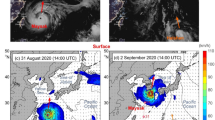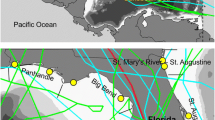Abstract
In early 2008, cold water in the Taiwan Strait (TWS) was moved sequentially by a cross-strait flow and a southward flow to the Penghu Island, causing a cold-related fish kill disaster. Except for the local wind forcing, the coastal-trapped waves (CTWs), intermittently propagating toward the TWS from north in winter, are an additional factor that could impact the flow patterns by changing cross-strait sea-level gradient during the disaster. In the first stage (January 28–February 7), the reach of a large CTW trough induced an additional northward flow, which formed a cyclone after turning around the Zhangyun Ridge. Then, the cyclone led to an additional cross flow, which enhanced an eastward (offshore) movement of cold water. In the second stage (February 7–14), the arrival of a large CTW crest triggered an additional southward flow, which intensified a southward movement of the cold water. Due to the additional eastward and southward movements caused by the CTWs, the cold water could reach Penghu Island inducing a cold disaster.








Similar content being viewed by others
References
Chang Y, Lee KT, Lee MA, Lan KW (2009) Satellite observation on the exceptional intrusion of cold water in the Taiwan Strait. Terr Atmos Ocean Sci 20:661–669
Chapman DC (1985) Numerical treatment of cross-shelf open boundaries in a barotropic coastal ocean model. J Phys Oceanogr 15:1060–1075
Chen DK, Su JL (1987) Continental shelf waves study along China Coast (in Chinese). Acta Oceanol Sin 9:1–15
Chen Z, Yan X-H, Jiang Y (2014) Coastal cape and canyon effects on wind-driven upwelling in northern Taiwan Strait. J Geophys Res Oceans 119:4605–4625
Ezer T, Atkinson LP, Corlett WB, Blanco JL (2013) Gulf Stream’s induced sea level rise and variability along the U.S. mid-Atlantic coast. J Geophys Res Oceans 118:685–697
Flather RA (1987) A tidal model of the Northeast Pacific. Atmosphere-Ocean 25:22–45
Hsieh HJ, Hsien YL, Jeng MS, Tsai WS, Su WC, Chen CA (2008) Tropical fishes killed by the cold. Coral Reefs 27:599–599
Huang NE, Shen Z, Long SR, Wu MC, Shih HH, Zheng Q, Yen NC, Tung CC, Liu HH (1998) The empirical mode decomposition and the Hilbert spectrum for nonlinear and non-stationary time series analysis. Proceedings of the Royal Society A: Mathematical, Physical and Engineering Sciences 454:903–995
Jacobs GA, Preller RH, Riedlinger SK, Teague WJ (1998a) Coastal wave generation in the Bohai Bay and propagation along the Chinese Coast. Geophys Res Lett 25:777–780
Jacobs GA, Teague WJ, Riedlinger SK, Preller RH, Blaha JP (1998b) Sea surface height variations in the Yellow and East China Seas-2. SSH variability in the weekly and semiweekly bands J Geophys Res Oceans 103:18479–18496
Jan S, Wang J, Chern CS, Chao SY (2002) Seasonal variation of the circulation in the Taiwan Strait. J Mar Syst 35:249–268
Jan S, Sheu DD, Kuo HM (2006) Water mass and throughflow transport variability in the Taiwan Strait. J Geophys Res Oceans 111:C12012
Ko DS, Preller RH, Jacobs GA, Tang TY, Lin SF (2003) Transport reversals at Taiwan Strait during October and November 1999. J Geophys Res Oceans 108:3370
Li L (1989) A study of winter subtidal sea level fluctuation in the Taiwan Strait. Acta Oceanol Sin 11:275–283
Li C, Hu J, Jan S, Wei Z, Fang G, Zheng Q (2006a) Winter-spring fronts in Taiwan Strait. J Geophys Res 111
Li CY, Hu JY, Jan S, Wei ZX, Fang GH, Zheng QN (2006b) Winter-spring fronts in Taiwan Strait. J Geophys Res 111:C11S13. doi:10.1029/2005jc003203
Li F, Jo Y-H, Liu WT, Yan X-H (2012) A dipole pattern of the sea surface height anomaly in the North Atlantic: 1990s–2000s. Geophys Res Lett 39
Liao EH, Jiang YW, Li L, Hong HS, Yan XH (2013a) The cause of the 2008 cold disaster in the Taiwan Strait. Ocean Model 62:1–10
Liao EH, Jiang YW, Yan XH, Chen ZY, Wang J, Zhang LP (2013b) Allocation of marine environmental carrying capacity in the Xiamen Bay. Mar Pollut Bull 75:21–27
Liao EH, Lu WF, Yan X-H, Jiang YW, Kidwell A (2015) The coastal ocean response to the global warming acceleration and hiatus. Sci Rep 5:16630
Lin X, Yan X-H, Jiang Y, Zhang Z (2016) Performance assessment for an operational ocean model of the Taiwan Strait. Ocean Model 102:27–44
Lu W, Yan X-H, Jiang Y (2015) Winter bloom and associated upwelling northwest of the Luzon Island: a coupled physical-biological modeling approach. J Geophys Res Oceans 120:533–546
Ma C, Wu D, Lin X, Yang J, Ju X (2010) An open-ocean forcing in the East China and Yellow seas. J Geophys Res 115:C12056
Moon J-H, Hirose N (2014) Seasonal response of the southern East China Sea shelf water to wind-modulated throughflow in the Taiwan Strait. Prog Oceanogr 121:74–82
Oey LY, Chang YC, Lin MC, Chang S, Varlamov YM (2014) Cross flows in the Taiwan Strait in winter. J Phys Oceanogr 44:801–817
Shchepetkin AF, Mcwilliams JC (2003) A method for computing horizontal pressure-gradient force in an oceanic model with a nonaligned vertical coordinate. J Geophys Res Oceans 108:3090
Shchepetkin AF, Mcwilliams JC (2005) The regional oceanic modeling system (ROMS): a split-explicit, free-surface, topography-following-coordinate oceanic model. Ocean Model 9:347–404
Tang HG (1978) The situations and reciews of the mass mortalities due to freeze during winter time in Pescadores (in Chinese). China Fish Mon 302:24–26
Wang J, Yuan YL, Pan ZD (1988) Numerical studies and analysis about continental shelf waves (in Chinese). Acta Oceanol Sin 10:666–677
Wang J, Hong H, Jiang Y, Chai F, Yan X-H (2013) Summer nitrogenous nutrient transport and its fate in the Taiwan Strait: a coupled physical-biological modeling approach. J Geophys Res Oceans 118:4184–4200
Yang JY (2007) An oceanic current against the wind: how does Taiwan Island steer warm water into the East China Sea? J Phys Oceanogr 37:2563–2569
Yin L, Qiao F, Zheng Q (2014) Coastal-trapped waves in the East China Sea observed by a mooring array in winter 2006. J Phys Oceanogr 44:576–590
Zhu D, Li L, Guo X (2013) Seasonal and interannual variations of surface current in the southern Taiwan Strait to the west of Taiwan Shoals. Chin Sci Bull 58:4171–4178
Acknowledgements
This work was supported by grant 41476005 from the Natural Science Foundation of China (NSFC), grant U1305231 from both NSFC and Fujian Province, grant 2013CB955704 from the National Basic Research Program of China, and grant 2013BAB04B00 from National Key Technology Support Program.
Author information
Authors and Affiliations
Corresponding author
Additional information
Responsible Editor: Guoping Gao
Key points
• CTWs induced by remote wind can impact circulation in the Taiwan Strait.
• A CTW trough enhanced cold water offshore transport in the first stage.
• A CTW crest intensified cold water southward intrusion in the second stage.
This article is part of the Topical Collection on the 8th International Workshop on Modeling the Ocean (IWMO), Bologna, Italy, 7-10 June 2016
Rights and permissions
About this article
Cite this article
Liao, E., Yan, XH. & Jiang, Y. The role of coastal-trapped waves on the 2008 cold disaster in the Taiwan Strait. Ocean Dynamics 67, 611–619 (2017). https://doi.org/10.1007/s10236-017-1042-7
Received:
Accepted:
Published:
Issue Date:
DOI: https://doi.org/10.1007/s10236-017-1042-7




